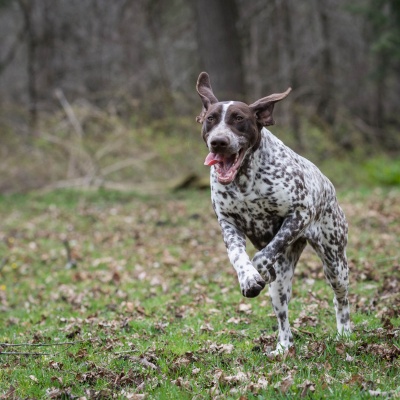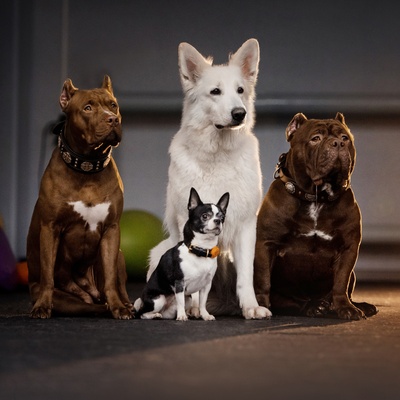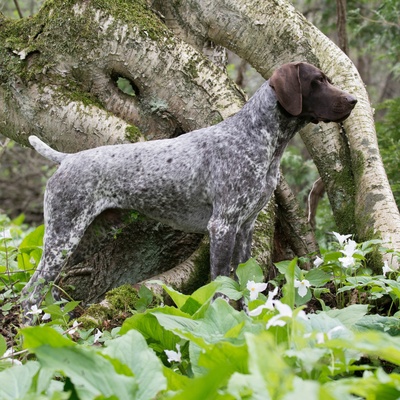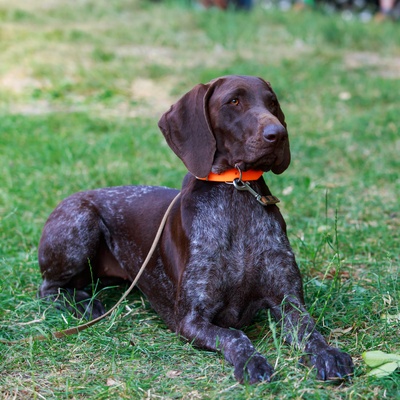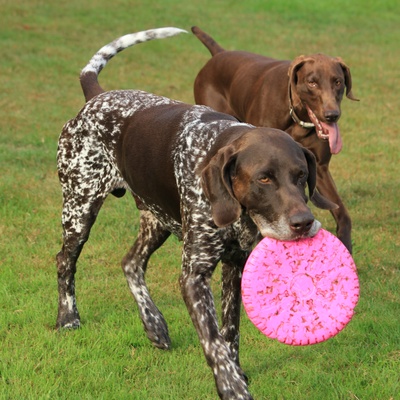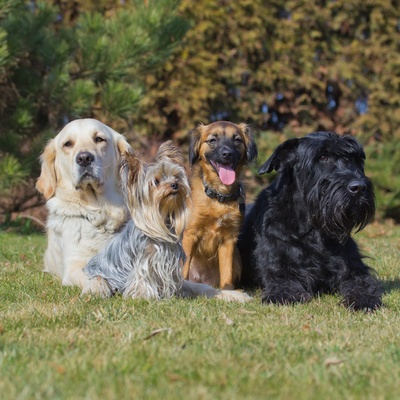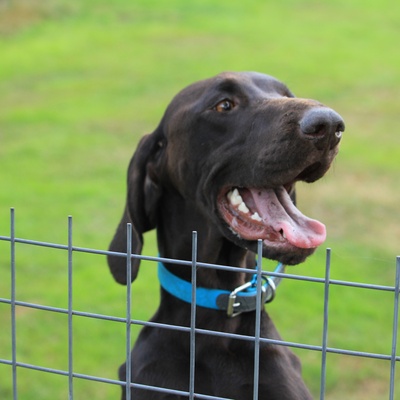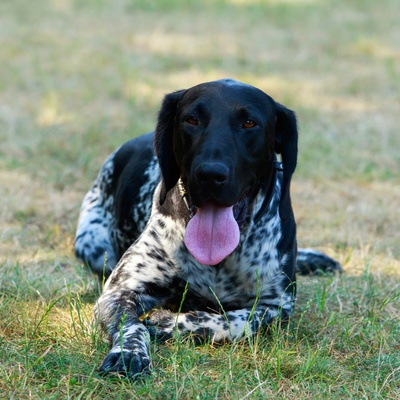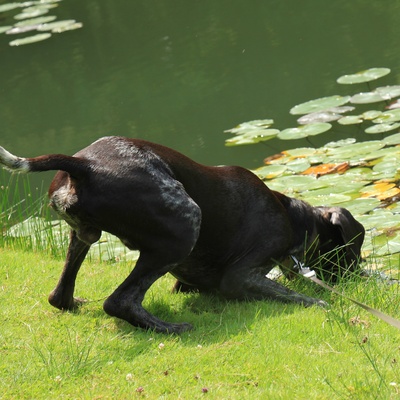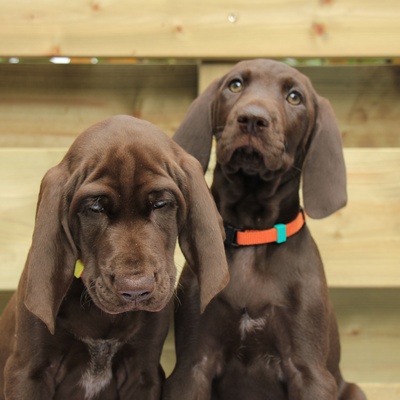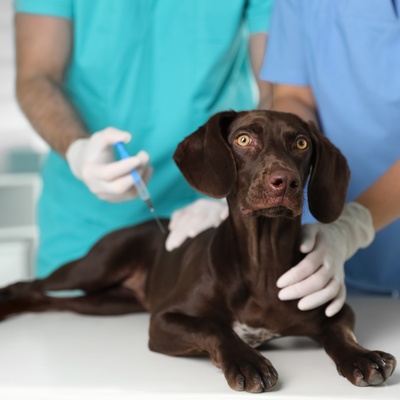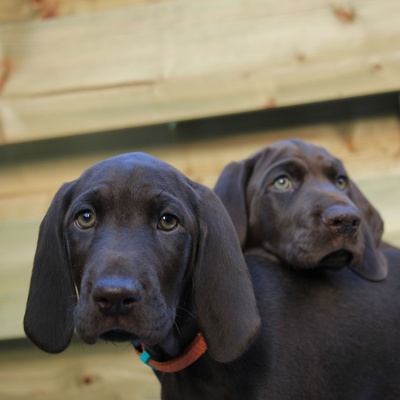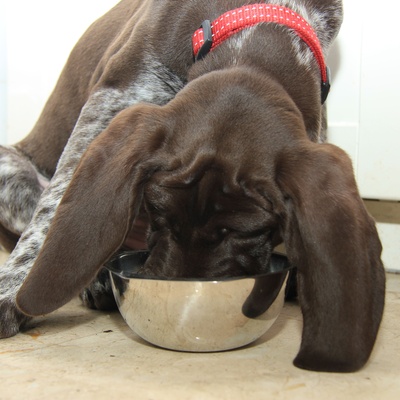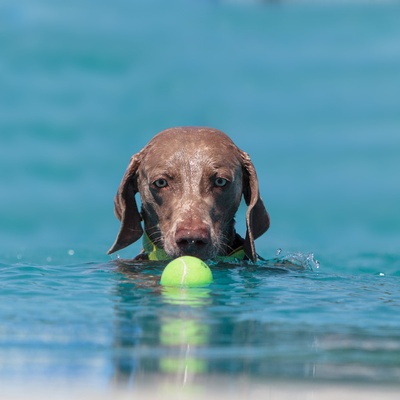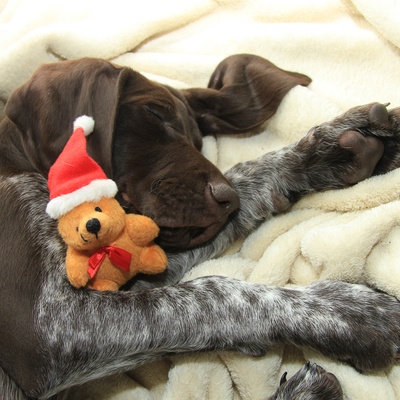Introducing the German Shorthaired Pointer
Discover all there is to know about the German Shorthaired Pointer: its characteristics, behavior, training, and its cost.

Discover all there is to know about the German Shorthaired Pointer: its characteristics, behavior, training, and its cost.
Originating in Germany in the 19th century, the German Shorthaired Pointer (GSP) is a testament to careful breeding for versatility in hunting and companionship. This breed, developed from a mix of Spanish Pointers and local German hounds, has become one of the most admired and popular sporting dogs across the globe. Known for their bravery, intelligence, and remarkable adaptability, GSPs excel in various disciplines.
Whether it's serving as a loyal hunting companion, participating in competitive sports, or being a loving family pet, the German Shorthaired Pointer stands out. Their innate qualities of loyalty, affection, and eagerness to please make them an ideal choice for active families. Moreover, their sociable nature and tendency to express affection generously endear them to everyone they meet, making the GSP a truly versatile and beloved member of the canine world.
This section outlines the unique features of the German Shorthaired Pointer breed.
The German Shorthaired Pointer belongs to the sporting group, comprising dogs bred for hunting and field. These dogs excel in various roles from hunting to companionship, showcasing a versatile temperament.
The German Shorthaired Pointer is a medium to large-sized dog, generally standing between 21 to 25 inches at the shoulder and weighing between 45 to 70 pounds.
German Shorthaired Pointers possess a short, thick coat that is water-resistant. Their fur is sleek and easy to maintain, offering them protection in various weather conditions.
The coat of a German Shorthaired Pointer can vary but is predominantly liver (brown) or liver and white in color.
German Shorthaired Pointers are adaptable to both country and city living environments. However, they thrive in spaces where they can exercise freely and have access to open spaces.
Known for their friendly and sociable nature, German Shorthaired Pointers are excellent with children and get along well with other animals.
Generally, German Shorthaired Pointers are healthy dogs but can be predisposed to certain genetic conditions, such as hip dysplasia and heart disorders.
The German Shorthaired Pointer is highly intelligent and eager to please. They respond best to positive reinforcement techniques, requiring patience and consistency for optimal results.
We can help you!
Every dog has its own character and specific needs. Making the right choice will ensure his well-being and yours.
Thanks to our quiz, you'll know which breed is right for you, depending on your personality, lifestyle and many other criteria.
Don't wait any longer and take the quiz to find out the answer!
German Shorthaired Pointers are medium to large-sized dogs known for their sleek, muscular build and striking balance. They boast a short, dense coat, typically liver or liver and white in color, which adds to their elegant appearance.
The German Shorthaired Pointer is a large dog breed with females usually standing between 21 and 23 inches tall, and males reaching 23 to 25 inches in height. Regarding weight, females typically range from 45 to 60 pounds, while males are slightly heavier, ranging from 55 to 70 pounds.
German Shorthaired Pointers experience a rapid growth phase, quickly reaching a significant portion of their adult weight by 6 months of age. However, they don't fully mature until they are about 18 to 24 months old, at which point they've reached both their final size and weight, ready to channel their energy into the numerous activities they excel at.
The German Shorthaired Pointer is adorned with a short, dense coat that is sleek to the touch, offering a streamlined appearance ideal for their active lifestyle. The absence of fringes or waves simplifies maintenance, making it perfectly suited for a dog that loves outdoor adventures.
The coat color of the German Shorthaired Pointer varies primarily within the spectrum of liver and white. These colors can appear in solid liver, liver and white patched, ticked, or roaned patterns, showcasing a distinctive and attractive appearance. The variety within this color palette allows for a range of expressions, each unique to the individual dog.
The coat of the German Shorthaired Pointer is relatively low maintenance due to its length and texture. Despite the shortness of their fur, these dogs do shed throughout the year, with seasonal peaks. Regular brushing, about once a week, is sufficient to remove loose hair and maintain the coat's natural sheen.
This breed's coat does not require frequent baths; washing them as needed or every few months is adequate, especially since they are less likely to get as dirty as longer-haired breeds. It's essential to keep their coat dry and clean, especially after outdoor activities, to maintain their skin health and overall well-being.
The German Shorthaired Pointer epitomizes balance and proportion in its build, embodying the essence of a versatile hunting dog. The head presents a noble and intelligent expression, with a broad skull and a muzzle that is long enough to grasp game. Their eyes, almond-shaped and dark brown, convey alertness and a keen eagerness. Positioned high, their ears are broad and set to lay flat against the head, framing the face.
The body showcases a distinct musculature, indicative of the breed's athleticism; a strong back and a well-sprung ribcage lead to a slightly sloping topline, ending in a tail that is commonly docked in countries where it's legally permitted. This streamlined physique allows for the speed, agility, and endurance that the German Shorthaired Pointer is celebrated for, making them adept in both land and water activities.
The German Shorthaired Pointer is renowned for its loyalty, versatility, and affectionate nature, making it an adaptable and eager companion in various activities and family settings.
With over 400 recognized dog breeds categorized into 10 distinct groups, each group encompasses breeds that share similar characteristics and purposes. The German Shorthaired Pointer falls into the sporting group (7), which includes breeds like the Labrador Retriever, and Cocker Spaniel among its ranks. This group is characterized by breeds that are energetic, intelligent, and have a natural inclination towards working closely with humans, whether in hunting, retrieving, or performing in competitive sports.
The German Shorthaired Pointer exemplifies these traits, boasting a strong hunting instinct combined with an impressive level of intelligence and a friendly, trainable temperament. Primarily bred for hunting game, the German Shorthaired Pointer's versatility makes it a multifaceted companion, excelling in various roles beyond the field, including family life and competitive events.
German Shorthaired Pointers are known for their boundless energy and eagerness to please, making them lively and enthusiastic companions. Their affectionate nature means they form strong bonds with their owners, often showing their love through exuberant greetings and a desire to be close.
For the German Shorthaired Pointer to thrive, it requires an owner who is just as active and involved, providing ample opportunities for physical and mental stimulation. While they do possess a degree of independence, their development into well-rounded dogs hinges on consistent interaction and engagement with their family.
The German Shorthaired Pointer's sociability and outgoing personality make it a joy in any setting. They are known to be exceptionally friendly, not just with their human family but also with strangers, making them poor choices for guard dogs but excellent for families looking for a sociable pet. Their gentle nature and patience make them wonderful companions for children, offering loyalty and protection alongside playful camaraderie.
However, like all dogs, early socialization is crucial to ensure they grow up to be well-adjusted adults, capable of interacting positively with a variety of people and animals. This breed's innate friendliness is complemented by an intelligent curiosity, making them not only willing but also eager to make new friends and explore new environments.
Take the test and find out the dog breed that matches your personality and lifestyle.
German Shorthaired Pointers are remarkably adaptable, capable of thriving in diverse living situations, from apartments in bustling cities to spacious homes in the countryside. However, the key to their happiness transcends their physical environment; it lies in the quality of attention and interaction they receive from their owners.
These active dogs need substantial daily exercise, with walks ideally extending beyond an hour in total, split into sessions to satisfy both their physical and mental stimulation needs.
The adaptability of the German Shorthaired Pointer is only matched by their need for a dynamic outdoor environment where they can channel their energy and satisfy their innate curiosity. While they can adjust to living in smaller spaces, access to a secure outdoor area where they can run, explore, and play is highly beneficial.
This breed's athletic and adventurous spirit means they excel in environments that offer them the freedom to move and engage in activities such as running, swimming, and interactive play, ensuring their well-being and fostering a balanced temperament.
The German Shorthaired Pointer is distinguished by its rapid learning ability and superior intelligence, making it an exceptionally trainable breed. Their eagerness to please and natural instinct for hunting and retrieving translate into a training process that, while straightforward, requires consistency and engagement.
To harness their potential fully, training should begin early, incorporating a mix of obedience, agility, and scent work that plays to their strengths. Given their adventurous spirit and propensity for exploration, outfitting them with a GPS collar can be a prudent measure to prevent losses or escapes, ensuring they can be safely tracked during outdoor activities.
German Shorthaired Pointers are noted for their remarkable listening qualities, showing an attentiveness in training that facilitates their ability to follow commands and cues with precision. This breed possesses a unique blend of intelligence and enthusiasm for work, making them not only excellent hunting dogs but also versatile in various canine sports and activities.
Training should leverage positive reinforcement techniques, celebrating their achievements and encouraging their cooperative nature. Due to their high energy levels and strong desire for physical and mental stimulation, engaging and varied training sessions will keep them motivated and focused, ensuring their talents are nurtured effectively.
The German Shorthaired Pointer is generally known for its robust health and vitality. Consistent daily care is crucial in maintaining this breed's well-being, with a strong emphasis on preventive measures to guard against diseases and infections.
Overall, German Shorthaired Pointers enjoy good health but, like any breed, they have their susceptibilities. They are predominantly robust, yet they can be prone to certain hereditary conditions such as hip dysplasia, bloat (gastric torsion), and congenital heart defects.
Symptoms and severity can vary, but awareness and early detection can significantly impact their health outcomes. Eye conditions, such as progressive retinal atrophy, and skin disorders may also occur. Typically, the lifespan of a German Shorthaired Pointer ranges from 10 to 14 years, reflecting their generally healthy constitution.
Regular veterinary visits are essential for the German Shorthaired Pointer, ensuring they stay up to date with vaccinations, deworming, and parasite prevention. Their short coat requires minimal grooming but should be brushed weekly to remove loose hair and maintain skin health. Ear cleaning and dental care are critical to prevent infections and periodontal disease, respectively.
While this breed is not known to be hypoallergenic, attention to diet and environmental factors is important to mitigate any potential allergies. Nail trimming should be done as needed to prevent discomfort and mobility issues. Being proactive and attentive to these routine care aspects will support a long, healthy life for your German Shorthaired Pointer.
Each dog breed comes with its own set of nutritional needs, and the German Shorthaired Pointer is no exception. Given their active lifestyle, a balanced diet rich in protein and vitamins is crucial to sustain their energy levels and overall health. Premium kibble formulated for active breeds can serve as a solid foundation, ensuring they receive the right balance of essential nutrients.
For those German Shorthaired Pointers with higher energy demands, supplementing their diet with lean cuts of white and red meat can provide additional protein. However, it's important to keep fat intake moderate to prevent unnecessary weight gain. Proper nutrition is key to maintaining the vitality, strength, and health of your German Shorthaired Pointer, so careful consideration of their diet is imperative.
The German Shorthaired Pointer is highly regarded for its versatility and intelligence, making it a sought-after breed. There are numerous breeders across Great Britain, reflecting its popularity. It's important to consider several factors before adopting.
Before adopting a German Shorthaired Pointer, it’s crucial to make an informed decision. Ensure the breeder is reputable by visiting their premises to observe the dogs' living conditions and behavior firsthand. It's vital to inquire about the health of both the puppy and its parents, seeking transparency on any hereditary conditions.
Lastly, you must have your dog microchipped by the age of 8 weeks old and have their details registered on a relevant database like Petlog or Animal Tracker. This is a legal requirement in Great Britain, and failure to comply could result in a
fine. Microchipping can be done by a vet for a small fee, or for free at any Blue Cross center.
The cost of acquiring a German Shorthaired Pointer can vary widely, influenced by factors such as the dog's lineage, pedigree, breeder reputation, and age. On average, the price for a puppy may range from
to
.
It's important to remember that the initial purchase price is just the beginning; annual expenses for maintaining a German Shorthaired Pointer, including food, veterinary care, and other essentials, can average between
to
. Prospective owners should prepare for these ongoing costs to ensure their German Shorthaired Pointer leads a healthy, fulfilled life.
Choosing a dog that matches your personality and lifestyle will ensure your well-being and his!
To access the most relevant information, suitable payment methods, and delivery in your region, please select the website corresponding to your country.
